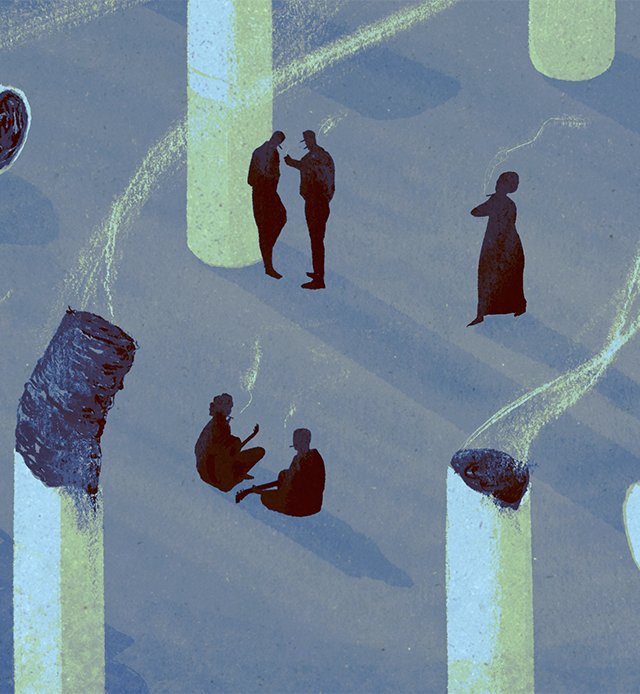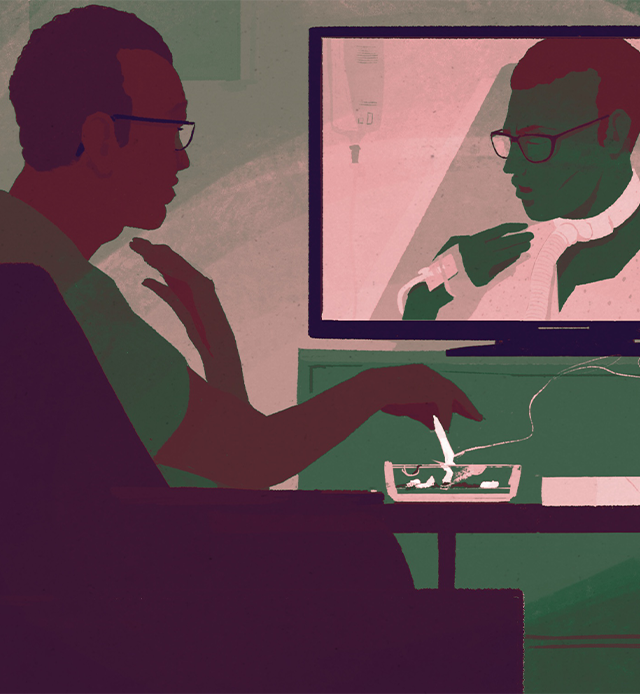Challenge
Illicit Trade
The tobacco industry consistently uses the supposed threat of increasing illicit trade in cigarettes to undermine tobacco control efforts. Tobacco companies greatly exaggerate their size estimates and place the blame on tobacco control policies. In reality, the challenge is almost always much smaller and there are widely-available and cost-effective tools available to manage and mitigate it, including in lower-income countries. Furthermore, tobacco companies are often complicit in the illicit trade about which they complain. Governments need to be aware of and reject these false narratives, as well as pursue the effective and proven steps that can be taken to secure the supply chain— for example through tracking and tracing tobacco products and strengthening law enforcement— as detailed in the Protocol to Eliminate Illicit Trade in Tobacco Products. Illicit trade is not a reason to slow or stop progress in tobacco control.
- Last updated:
Analyses of the illicit cigarette trade by industry-independent researchers show that the tobacco industry consistently overestimates the size of the problem and misrepresents its trends and nature. At the same time, the industry pushes the erroneous narrative that tobacco control policies, such as taxation, are responsible for causing or exacerbating the illicit market. Governments should not be deterred by this false narrative in their tobacco control efforts. There are effective and proven strategies to prevent or reduce illicit trade, such as securing the supply chain by tracking and tracing cigarette packs and strengthening law enforcement as detailed in the Protocol to Eliminate Illicit Trade in Tobacco Products.
The tobacco industry misrepresents illicit trade by overestimating the scope of the problem, claiming it is increasing over time, and hiding the fact that almost all illicit cigarettes were once legal—in other words, tax-paid in their place of manufacture. Most of these cigarettes were originally produced by the same companies that complain to policy makers about the illicit market. With these misrepresentations, the industry aims to deter or reverse effective tobacco tax policies and other tobacco control efforts.
Independent studies—which are fortunately growing around the world— consistently find that levels of illicit trade are lower and more manageable than claimed by tobacco companies. It is crucial that governments rely on rigorous, industry-independent estimates of illicit trade when developing and implementing policies, rather than allowing overestimations to mislead policy efforts.
The tobacco industry regularly misrepresents the dynamics to favor its narrative. For example, it will show changes in the illicit market share rather than changes in absolute quantity of illicit products. For example, in Ireland, in absolute terms the illicit cigarette consumption is in decline, but the tobacco industry publicly and loudly used illicit market share as its measure to claim it was increasing. In this case, put simply, legal cigarette consumption was declining faster than the consumption of illicit cigarettes due significantly to the government’s tobacco control successes.
The tobacco industry narrative around illicit trade issues makes it seem as if counterfeiting is the main problem. But most illicit cigarettes begin legally, meaning they are tax-paid by legal producers in the jurisdiction of manufacture. This includes most smuggled cigarettes. Or, legal manufacturers under-declare their production to authorities to evade taxes. In the case of “illicit whites”, these are products often made legally in a factory with the approval of the local licensing authority but mostly intended to be sold illegally into other markets. Remarkably, the tobacco industry continues to attribute illicit products to criminals and calls for governments to join their efforts in fighting them. This is mostly a diversion from the real health and economic problems created by legal tobacco sales and consumption. While precise proportions in the figure below likely differ from what the industry is claiming, one key take-home point is that even in its own estimates, the tobacco industry identifies that almost all illicit cigarettes (up to 93%) have strong—often direct— connections to legal producers. Counterfeit—something that is clearly illegal—is truly the rare exception.
In addition to misrepresenting the scale and scope of the problem, the industry pushes the narrative that the answer to illicit trade is not implementing or weakening effective tobacco control policies, falsely claiming that these measures contribute to and/or exacerbate the problem. The industry seeks to position itself as a genuinely concerned stakeholder on the topic implying that the tobacco control community does not understand nor care about the illicit market. However, experiences from countries around the world continue to disprove such claims with no indication that effective tobacco control including taxation, plain packaging, and other policies, lead to an uptick in illicit tobacco.
Examples
Illicit trade and taxes
Illicit trade and plain packaging
Following the implementation of plain packaging in Australia in 2012, there was no observed increase in the use of illicit cigarettes. Similarly, in the UK, Ireland, and France where plain packaging was implemented in 2017, availability of illicit cigarettes did not appear to increase. The percentage of people reporting being offered illicit cigarettes before and after full implementation of the measure even decreased between 2015 and 2018.
Following the implementation of plain packaging in Australia in 2012, there was no observed increase in the use of illicit cigarettes. Similarly, in the UK, Ireland, and France where plain packaging was implemented in 2017, availability of illicit cigarettes did not appear to increase. The percentage of people reporting being offered illicit cigarettes before and after full implementation of the measure even decreased between 2015 and 2018.
Illicit trade and menthol bans
In 2015, Canada’s province of Nova Scotia became the first jurisdiction in the world to ban menthol cigarette sales. The declining number of seized illicit cigarettes following the ban strongly supports the province’s tax authority’s reports of no increase in illicit cigarette sales.
In 2015, Canada’s province of Nova Scotia became the first jurisdiction in the world to ban menthol cigarette sales. The declining number of seized illicit cigarettes following the ban strongly supports the province’s tax authority’s reports of no increase in illicit cigarette sales.
Illicit trade and display bans
Illicit trade and bans on small packs
International consensus on how to combat illicit trade in tobacco products
The industry ignores the international consensus on how to effectively address illicit trade contained in the Protocol to Eliminate Illicit Trade in Tobacco Products, an international treaty which entered into force in September 2018. The Protocol’s objective is to eliminate all forms of illicit trade in tobacco products through a comprehensive package of evidence-based measures implemented cooperatively by countries.
The Protocol provides recommendations to fight illicit trade around the world, including the implementation of a global tracking and tracing system to secure the supply chain of tobacco products and equip national authorities with a platform for the exchange of information to determine the origin, transportation routes, intended markets of sale, and potential points of diversion of the products.
The tobacco industry has a long history of presenting itself as a strong, legitimate partner in securing the supply chain, even going as far as developing and selling its own tracking and tracing system. But there is clear evidence that major tobacco companies have been repeatedly complicit in major smuggling efforts (e.g., Ukraine) and underreporting of legal production (e.g., Pakistan) to evade paying taxes. As a result, the Protocol specifically stipulates that the obligations assigned to a Party in relation to setting up and maintaining a tracking and tracing system shall not be performed by or delegated to the tobacco industry.
Governments need to be aware of the tobacco industry’s false narratives and seek guidance from rigorous, independent (of the tobacco industry) research about the tobacco supply chain. The Protocol to Eliminate Illicit Trade in Tobacco Products details effective and proven steps that policy makers can take to prevent and reduce illicit trade. Experiences from around the world demonstrate that such measures can even be taken in tandem with evidence-based tobacco control policies.
References
Estimates of illicit trade of tobacco:
Stoklosa M, Ross H. Contrasting academic and tobacco industry estimates of illicit cigarette trade: evidence from Warsaw, Poland. Tobacco Control 2014;23:e30-e34.
Chen, Jing, Sarah M. McGhee, Joy Townsend, Tai Hing Lam, and Anthony J. Hedley. “Did the Tobacco Industry Inflate Estimates of Illicit Cigarette Consumption in Asia? An Empirical Analysis.” Tobacco Control 24, no. e2 (June 1, 2015): e161–67. https://doi.org/10.1136/tobaccocontrol-2014-051937.
Drope J, Rodriguez-Iglesias G, Stoklosa M, Szklo A. Recent evidence on the illicit cigarette trade in Latin America. Rev Panam Salud Publica. 2022;46:e111. https://doi.org/10.26633/RPSP.2022.111.
Stoklosa, Michal. “Is the Illicit Cigarette Market Really Growing? The Tobacco Industry’s Misleading Math Trick.” Tobacco Control 25, no. 3 (May 1, 2016): 360–61. https://doi.org/10.1136/tobaccocontrol-2015-052398.
Do tobacco taxes increase illicit trade?
Tobacco Taxes and the Threat of the Illicit Market: Asia | Tobacconomics
Tobacco Taxes and the Threat of the Illicit Market: Latin America | Tobacconomics
Tobacco Taxes and the Threat of the Illicit Market: Southeastern Europe | Tobacconomics
Nguyen A, Nguyen HT. Tobacco excise tax increase and illicit cigarette consumption: evidence from Vietnam. Tob Control. 2020;29(Suppl 4):s275-s280. doi:10.1136/tobaccocontrol-2019-055301
Do other tobacco control measures increase illicit trade?
Scollo M, Zacher M, Coomber K, Wakefield M. Use of illicit tobacco following introduction of standardised packaging of tobacco products in Australia: results from a national cross-sectional survey. Tob Control. 2015;24(Suppl 2):ii76-ii81. doi:10.1136/tobaccocontrol-2014-052072
Laverty AA, Millett C, Hopkinson NS, Filippidis FT. Introduction of standardised packaging and availability of illicit cigarettes: a difference-in-difference analysis of European Union survey data 2015-2018. Thorax. 2021;76(1):89-91. doi:10.1136/thoraxjnl-2020-215708
U.S. National Cancer Institute and World Health Organization. The Economics of Tobacco and Tobacco Control. National Cancer Institute Tobacco Control Monograph 21. NIH Publication No. 16-CA-8029A. Bethesda, MD: U.S. Department of Health and Human Services, National Institutes of Health, National Cancer Institute; and Geneva, CH: World Health Organization; 2016. This monograph and its supplemental materials may be found electronically at http://cancercontrol.cancer.gov/brp/tcrb/monographs/21/index.htm
How to combat illicit trade?
Protocol to Eliminate Illicit Trade in Tobacco Products Protocol to Eliminate Illicit Trade in Tobacco Products (who.int)
Confronting Illicit Tobacco Trade : a Global Review of Country Experiences : Confronting Illicit Tobacco Trade : a Global Review of Country Experiences (English). WBG Global Tobacco Control Program Washington, D.C. : World Bank Group. http://documents.worldbank.org/curated/en/677451548260528135/Confronting-Illicit-Tobacco-Trade-a-Global-Review-of-Country-Experiences
Industry complicit in illicit production in Ukraine
Joossens L, Gilmore AB, Stoklosa M, Ross H. Assessment of the European Union’s illicit trade agreements with the four major transnational tobacco companies. Tobacco Control. 2016 May 1;25(3):254-60. https://tobaccocontrol.bmj.com/content/tobaccocontrol/25/3/254.full.pdf
Industry Underreporting in Pakistan
Sabir, M., Saleem, W., & Iqbal, M.M. (2022). Estimating the Under-reporting of Cigarette Production in Pakistan (Tobacconomics Working Paper No.22/9/2). SPDC. https://tobacconomics.org/research/estimating-the-underreporting-of-cigarette-production-in-pakistan-working-paper-series.
Estimates of illicit trade of tobacco:
Stoklosa M, Ross H. Contrasting academic and tobacco industry estimates of illicit cigarette trade: evidence from Warsaw, Poland. Tobacco Control 2014;23:e30-e34.
Chen, Jing, Sarah M. McGhee, Joy Townsend, Tai Hing Lam, and Anthony J. Hedley. “Did the Tobacco Industry Inflate Estimates of Illicit Cigarette Consumption in Asia? An Empirical Analysis.” Tobacco Control 24, no. e2 (June 1, 2015): e161–67. https://doi.org/10.1136/tobaccocontrol-2014-051937.
Drope J, Rodriguez-Iglesias G, Stoklosa M, Szklo A. Recent evidence on the illicit cigarette trade in Latin America. Rev Panam Salud Publica. 2022;46:e111. https://doi.org/10.26633/RPSP.2022.111.
Stoklosa, Michal. “Is the Illicit Cigarette Market Really Growing? The Tobacco Industry’s Misleading Math Trick.” Tobacco Control 25, no. 3 (May 1, 2016): 360–61. https://doi.org/10.1136/tobaccocontrol-2015-052398.
Do tobacco taxes increase illicit trade?
Tobacco Taxes and the Threat of the Illicit Market: Asia | Tobacconomics
Tobacco Taxes and the Threat of the Illicit Market: Latin America | Tobacconomics
Tobacco Taxes and the Threat of the Illicit Market: Southeastern Europe | Tobacconomics
Nguyen A, Nguyen HT. Tobacco excise tax increase and illicit cigarette consumption: evidence from Vietnam. Tob Control. 2020;29(Suppl 4):s275-s280. doi:10.1136/tobaccocontrol-2019-055301
Do other tobacco control measures increase illicit trade?
Scollo M, Zacher M, Coomber K, Wakefield M. Use of illicit tobacco following introduction of standardised packaging of tobacco products in Australia: results from a national cross-sectional survey. Tob Control. 2015;24(Suppl 2):ii76-ii81. doi:10.1136/tobaccocontrol-2014-052072
Laverty AA, Millett C, Hopkinson NS, Filippidis FT. Introduction of standardised packaging and availability of illicit cigarettes: a difference-in-difference analysis of European Union survey data 2015-2018. Thorax. 2021;76(1):89-91. doi:10.1136/thoraxjnl-2020-215708
U.S. National Cancer Institute and World Health Organization. The Economics of Tobacco and Tobacco Control. National Cancer Institute Tobacco Control Monograph 21. NIH Publication No. 16-CA-8029A. Bethesda, MD: U.S. Department of Health and Human Services, National Institutes of Health, National Cancer Institute; and Geneva, CH: World Health Organization; 2016. This monograph and its supplemental materials may be found electronically at http://cancercontrol.cancer.gov/brp/tcrb/monographs/21/index.htm
How to combat illicit trade?
Protocol to Eliminate Illicit Trade in Tobacco Products Protocol to Eliminate Illicit Trade in Tobacco Products (who.int)
Confronting Illicit Tobacco Trade : a Global Review of Country Experiences : Confronting Illicit Tobacco Trade : a Global Review of Country Experiences (English). WBG Global Tobacco Control Program Washington, D.C. : World Bank Group. http://documents.worldbank.org/curated/en/677451548260528135/Confronting-Illicit-Tobacco-Trade-a-Global-Review-of-Country-Experiences
Industry complicit in illicit production in Ukraine
Joossens L, Gilmore AB, Stoklosa M, Ross H. Assessment of the European Union’s illicit trade agreements with the four major transnational tobacco companies. Tobacco Control. 2016 May 1;25(3):254-60. https://tobaccocontrol.bmj.com/content/tobaccocontrol/25/3/254.full.pdf
Industry Underreporting in Pakistan
Sabir, M., Saleem, W., & Iqbal, M.M. (2022). Estimating the Under-reporting of Cigarette Production in Pakistan (Tobacconomics Working Paper No.22/9/2). SPDC. https://tobacconomics.org/research/estimating-the-underreporting-of-cigarette-production-in-pakistan-working-paper-series.




